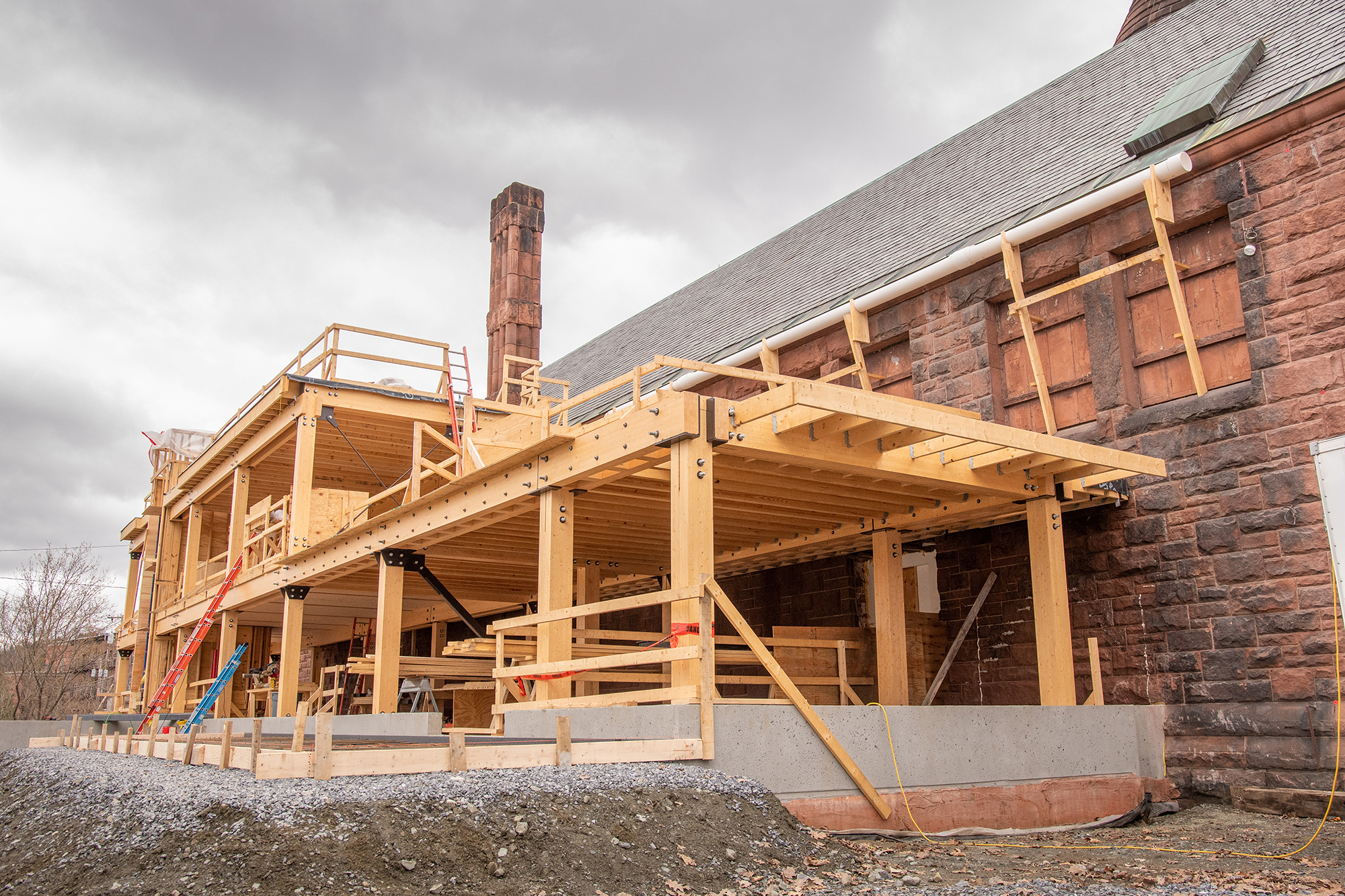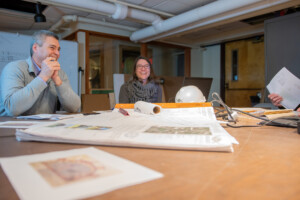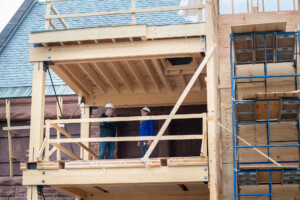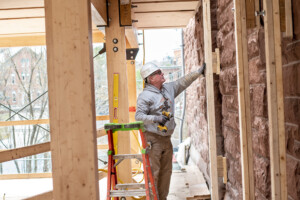Fairbanks Museum Home to Vermont’s First Demonstration Mass Timber Building
May 15, 2023

Aligned with the Fairbank’s commitment to decarbonization, the new addition is the first in the world to use regional hemlock in cross-laminated timber construction.
By Christine McGowan, Vermont Sustainable Jobs Fund
“The old adage was large columns, large trees,” said Ricky McLain, senior technical director at WoodWorks, “but we don’t need to cut down large trees to make columns and beams from wood anymore.”
That was the pitch Adam Kane, executive director of the Fairbanks Museum & Planetarium, heard from McLain in 2019. Intrigued by the possibility of using mass timber, which had also been suggested by Tim Tierney at the Vermont Agency of Commerce and Community Development, Kane decided to explore its use for an addition he was planning at the museum.
“It was a perfect fit for a number of reasons,” said Kane. “First and foremost, part of our mission is responsibility to the natural world, so using low-embodied carbon construction materials that are sourced locally aligns well with that.”

Adam Kane, executive director of the Fairbanks Museum & Planetarium in a meeting with Megan Nedzinski of Vermont Integrated Architecture, which designed the addition. Photo by Erica Houskeeper.
Kane adds that it was important for the 6,500 square foot addition to keep with the historic nature of the original building built in 1890, which has a primarily wood interior and low floor to ceiling height, requiring a relatively small structure depth. “We wanted the addition to feel both current and in harmony with the original building,” he said.
“Fairbanks is a gem of a building,” said Megan Nedzinski from Vermont Integrated Architecture who designed the addition in collaboration with Engineering Ventures. “Part of the motivation is the lower embodied energy, but the key driver is that it’s a local product. And it’s really, really beautiful.”
What exactly is mass timber?
Mass timber is an umbrella term used to describe a suite of engineered wood products. Cross-laminated timber and glulam beams which are being used at Fairbanks, consist of multiple wood panels that are glued together, providing strength and stability that is comparable to concrete, steel, and heavy timber. Other mass timber products use nails or dowels to create similar structural building components made of solid wood.
Traditionally, large diameter trees were used to provide structural support in buildings. Over decades, the industry moved away from “heavy timber” toward light frame construction, using steel and concrete to provide support in tall, commercial buildings and multi-family homes.

Megan Nedzinski of Vermont Integrated Architecture tours an upper floor of the museum’s addition with Adam Kane. Photo by Erica Houskeeper.
That has begun to shift as the understanding of a building’s carbon footprint expands beyond energy efficiency to include how and where materials are manufactured, and how far they have to travel. Demand for innovative low embodied carbon products has increased, bringing new thinking to how renewable resources, like wood, can replace fossil fuel intensive materials like steel and concrete.
“The built environment is responsible for 40 percent of global carbon emissions,” said Nedzinski. “It’s not just about insulation and replacing windows anymore. It’s also being conscious about the materials used from the ground up.”
In addition to lower emissions in the manufacturing process, wood stores carbon for as long as it remains in use, essentially locking in the carbon it has absorbed over its lifetime. “You’re keeping that carbon out of the environment for at least the life of the building,” said McLain, “possibly for generations.”
Particularly suited to tall buildings with six stories or more, mass timber is currently approved for use in buildings with up to 18 floors. That’s a change from a few years ago, when mass timber could only be used in buildings with five or six stories. “There’s a cost benefit analysis that doesn’t work as well in low- to mid-rise buildings with repetitive bearing walls,” said McLain. “To many developers, it’s hard to justify doing something solely for environmental benefits; the economics have to work as well. From a cost perspective, you really start to see that efficiency in post-and-beam buildings or taller buildings where lightframe construction is not utilized.”
In 2013, less than a decade ago, there were only about 20 mass timber projects in the US. Today, there are close to 1,750 projects. In New England alone, there are 104 mass timber projects in design and 56 projects that have been completed.
“While still a small percentage of the 17,000 building projects in the U.S. annually,” said McLain, “the trend line is growing, as is the average size of projects.”
The Vermont connection.
The mass timber demonstration project at the Fairbanks Museum takes the social and environmental benefits one step further by piloting the use of local wood.
Led by Charlie Levesque, a consultant and executive director of the North East State Foresters Association, and made possible by a $250,000 wood innovations grant from the USDA Forest Service, eastern hemlock has been tested and certified for use in cross-laminated timber. An abundant and underutilized tree species in the northeast, certification opens up a new market for eastern hemlock that Levesque and others anticipate will continue to grow.

An employee from Bread Loaf Corporation works on the addition, which will keep with the historic nature of the original building that was built in 1890. Photo by Erica Houskeeper.
Vermont currently has 28 million board feet of hemlock sawlogs cut each year. Hemlock has a net growth of 84 million board feet and is the third most abundant species in Vermont, with a growth/harvest ratio of 3:1. “In other words,” says Levesque, “we can use Hemlock for mass timber very sustainably.”
As a demonstration project, using local wood was important to Kane. “Although our project is too small to drive the supply chain to any significant extent, we were able to take some risk with a new species that we hope will pave the way for future projects,” he said.
The hemlock used at Fairbanks was sawed at White Mountain Lumber in Berlin, New Hampshire from trees harvested in Maine, Vermont, and New Hampshire. From there, it was kiln dried and finished at Cersosimo Lumber in Brattleboro, Vermont before traveling to the SmartLam CLT plant in Dothan, Alabama for manufacturing into the CLT, since no such facilities yet exist in New England. Levesque and others hope this pilot will be the first step toward an eventual manufacturing plant in New England.
“Vermont is set up well to be an example to other regions,” said McLain. “We have a rich history of timber frame construction that can be leveraged, the Northeast wood basket has capacity and needs a new market for softwood and, from a sustainability perspective, Vermont has always been a leader.”
New markets support sustainable forests.
As a demonstration project, every aspect of the addition at Fairbanks–from piloting eastern hemlock, to manufacturing and construction–is available to builders, architects, construction workers, and the general public who want to learn about mass timber.
“As a museum, we have the opportunity and duty to educate our visitors,” said Kane. “Just stating that we’re building a mass timber structure doesn’t convey what that means to the average visitor. So, with funding from the Softwood Lumber Board and the USDA grant, we created a mass timber exhibit constructed of CLT to give visitors an up-close experience with the material.”
The exhibit, which is open now through fall 2023, helps visitors draw a clear connection between the building and the surrounding environment.
Using local wood is not only good for extreme weather readiness, but also supports rural economies and careful stewardship of forested land. Vermont is 78 percent forested, and 80 percent of that forested land is privately owned and managed. New markets for underutilized species, such as eastern hemlock, create opportunities for both loggers and landowners to generate income from the land, which Levesque and others say is critical to preventing fragmentation and development.
“That’s why the USDA Forest Service was excited about supporting this project,” said McLain. “It’s helping create a market incentive for active forest management that will benefit the long term health of our forests.”
For more information, visit www.fairbanksmuseum.org and www.woodworks.org.
About the Vermont Forest Products Program at VSJF
Vermont’s forest economy contributes more than $2 billion in direct economic output and provides more than 13,000 jobs in forestry, logging, processing, specialty woodworking, construction, wood heating, maple production, and forest-based recreation. The Forest Products Program at the Vermont Sustainable Jobs Fund (VSJF) creates space for strong relationships and collaboration throughout the industry and promotes the development of new and existing markets for Vermont wood products. Committed to nurturing the sustainable development of Vermont’s economy, VSJF provides business assistance, network development, strategic planning, and value chain facilitation in agriculture and food system, forest products, waste management, renewable energy, and environmental technology sectors. Learn more at www.vsjf.org.




